The exposure of mammals to ionizing radiation leads to the development of a complex, dose-dependent series of changes, including injury to the lymphoid and hematopoietic systems, which can cause septicemia and death [1].
Damage to living tissue through a series of molecular events is brought by ionizing radiation. Thus, individuals exposed to radiation either due to occupational exposure or due to radiotherapy are at an increased risk of developing radiation sickness and several neoplastic sickness [2].
Studies also proved that cytokines act as a radiation mitigators which protects the bone marrow and intestinal crypts by stimulating the differentiation of stem cells, thereby prevents bone marrow failure and gastrointestinal syndrome which is a common symptom seen in the animals exposed to whole body radiation [4].
From the studies, it is proved cytokines like interleukins act as radiation mitigators [5] which lead us to investigate kinetin a plant cytokine, known for its anti-aging properties [6]. No study till date is done to check its potential to decrease radiation induced oxidative stress. Behavioural changes such as anxiety and learning ability are one of the important changes occurring due to radiation induced oxidative stress. Hence, this study was aimed to evaluate the effect of kinetin intervention on behavioural changes induced by sublethal dose of whole body radiation in Swiss albino mice.
Materials and Methods
The experimental study was conducted in Central Research Laboratory, and radiation studies were conducted in the Department of Oncology of KS Hegde Medical Academy, Mangalore, India, between December 2015 and February 2016. The study was conducted following the standard Committee for the Purpose of Control and Supervision of Experiments on Animals Guidelines and after the approval from Institutional Animal Ethical Committee.
Synthetic kinetin was purchased from Himedia. All the chemicals used in the study were of analytical grade.
Animals Used
In this study, the 20-25 g weighing healthy female (n=68) Swiss albino mice of six to eight weeks old were used.
Radiation Dose Specification
This study was conducted using the electron beam facility in the Department of Oncology, K. S. Hegde Medical Academy at the distance of 100 cm at the dose rate of 1 Gy/min and 15 MeV energy by placing in well ventilated Perspex box.
Survival Study
Dose fixation using Kaplan-Meier analysis: According to the data sheet and literature [7], LD 50 dose of kinetin in mice is 1000 mg/kg body weight.
Survival studies comprised 50 mice divided into five groups of 10 mice each. Group 1 was control Group 2 was radiation group and 5%, 10%, and 15% dose of LD 50 (i.e., 50 mg/kg body weight, 100 mg/kg body weight, and 150 mg/kg body weight) was selected for kinetin. Group 3, 4, and 5 mice were orally administered with a respective amount of kinetin for five consecutive days, and the Group 2 animals were exposed to lethal dose of 10 Gy of electron beam radiation on the sixth day. After irradiation, the animals were observed for survival and radiation symptoms for 30 days. Dose which provided maximum survival according to Kaplan-Meier analysis was selected for further studies.
Behavioural Studies
According to the [Table/Fig-1], in this study, three groups (six mice in each group) were included. Group 1 served as normal control, Group 2 served as radiation control, and Group 3 is the treatment group. The treatment group received a drug dosage of 100 mg/kg body of kinetin after exposing to the 6 Gy of electron beam radiation.
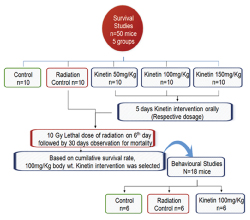
Evaluation of Anxiety Level in Irradiated and Treatment Groups [
8,
9]
To evaluate the anxiety level in mice, “open field exploration test” was conducted according to Hefner K et al., method [8,9].
Equipment: Include a square chamber ranging in size from 56 cm×56 cm made of wood. The open field arena was divided into a grid of equally sized areas by lines drawn on the chamber floor for visual scoring of activity.
Procedure: Once the animals were exposed to 6 Gy electron beam radiation, they were transported to the test room for acclimatization. The animal was allowed to habituate for one day. Next day, each mouse was placed in the center of a chamber. They were allowed to freely explore the test arena for five min. On completion of the test, mice were returned to the home cage. Time spent by each mouse in the center was noted. Mice spend significantly more time exploring the unprotected center area was considered anxiolytic like baseline behavior.
Evaluation of Learning Ability in Irradiated and Treatment Groups by Radial Maze Method [
10]
Equipment: Eight armed radial maze was used for this study. It is a specially designed instrument with the dimensions of each arm as follows, central platform measured 22 cm in diameter, arms were 25 cm long, 6 cm wide, and 6 cm high.
Procedure: Once the animals were exposed to 6 Gy electron beam radiation, they were transported to the test room. The animals were allowed to habituate for two days. Then, each mouse was trained for next two days for the task to be performed. Various visual clues were provided to aid the mice to learn about the task and entire lab setup was unaltered for next eight days of study. The unaided test was performed for next six days.
Task: Eight arms were assigned with a number from 1 to 8 clockwise, which remained same throughout the study. Each mouse was placed at the central platform facing toward the first arm and left to perform task for next five min. If mice crosses 3/4th distance of the arm, it was considered as valid. The task of each mouse is to enter each arm and travel to the valid distance and return back and re-enter to another arm in the order 1, 2, 3, 4, 5, 6, 7, and 8. Once the mice come out of the eight arm it is considered to complete the task. The time taken to perform the task and number of mistakes performed during the task was noted.
Statistical Analysis
The statistical analysis was performed by one-way ANOVA, and repeated measures ANOVA with Dennett’s multiple comparison tests as a post hoc test using PRISM 6.01 and SPSS 16.0 and results with p<0.05 were considered as statistically significant.
Results
Survival Studies
Dose Fixation using Kaplan-Meier analysis: Kaplan-Meier analysis is one of the versatile methods basically performed to know the trend of drug action (usually based on mortality). In this study, it was conducted to select an effective dose which will be used for further studies.
Dose selection: Based on the results [Table/Fig-2] obtained from survival studies, 100 mg/kg (10% of LD 50 value) body weight dose of kinetin were selected as the highest cumulative survival was observed in the same group for further studies.
Survival graph of kinetin.
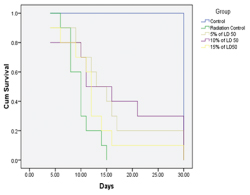
Behavioural Studies
Evaluation of anxiety level in irradiated and treatment groups by assessing open field behavior: From the result of [Table/Fig-3], it is evident that the 6 Gy whole body electron beam radiation had significantly increased the anxiety in mice as it spent most of its time in periphery of the maze. Although a trend of decrease in the level of anxiety was observed in the kinetin treatment group, the result was not statistically significant.
Graphical representation of anxiety level in various groups.
*Represent p<0.05. C, RC and K refer to control, radiation control and kinetin intervention group respectively.
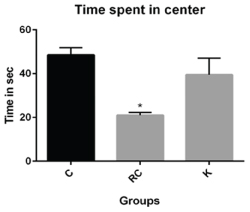
Evaluation of learning ability in irradiated and treatment groups by radial maze method: Result from [Table/Fig-4,5] suggest that radiation control group showed no significance changes in the average time taken to complete the task when compared with the normal control group but a significant decrease in the mean time taken to complete the task was observed in the treatment groups when compared with the radiation control groups.
Graphical representation of time taken to complete the task.
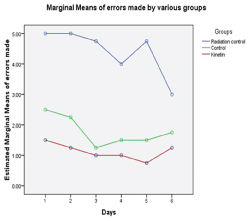
Multiple comparisons of mean time taken to complete the task.
| Dunnett’s (2-sided) |
|---|
| (I) Groups | (J) Groups | Mean difference (I-J) | Standard error | Sig. | 95% Confidence interval |
|---|
| Lower bound | Upper bound |
|---|
| Control | Radiation control | −0.4553 | 0.35505 | 0.531 | −1.4236 | 0.5130 |
| Kinetin | Radiation control | −1.4638* | 0.35505 | 0.003 | −2.4321 | −0.4954 |
*The mean difference is significant at the 0.05 level.
Results from [Table/Fig-6,7] suggest that radiation control group showed an increase in the average number of mistake done during the task when compared with the normal control groups. However, kinetin intervention groups showed a significant decrease in the average number of mistakes done while completing the task when compared with the radiation control.
Graphical representation of errors made during the task.
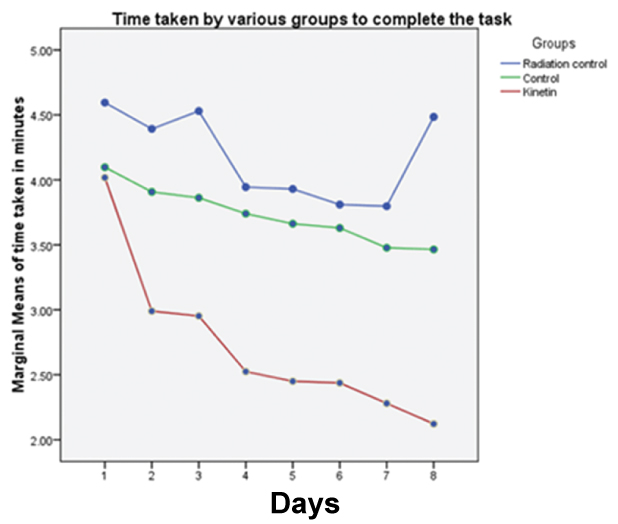
Multiple comparisons of mean errors made during the task.
| Dunnett’s (2-sided) |
|---|
| (I) Groups | (J) Groups | Mean difference (I-J) | Standard error | Sig. | 95% Confidence interval |
|---|
| Lower bound | Upper bound |
|---|
| Control | Radiation control | −2.6250* | 0.65068 | 0.004 | −4.3996 | −0.8504 |
| Kinetin | Radiation control | −3.2917* | 0.65068 | 0.001 | −5.0663 | −1.5171 |
*The mean difference is significant at the 0.05 level.
DISCUSSION
It is a well-established fact that ionizing radiation affects the living cell by producing free radicals there by increasing the oxidative stress. Radiation induced oxidative stress is known to play a major role in destruction of dopaminergic neurons which leads to the impairment in the parameters such as anxiety and learning ability [3]. This study aimed to assess the effect of radiation on behavioural changes such as anxiety and learning ability and to check the potency of kinetin intervention as an anxiolytic drug. Anxiety may be regarded as a particular form of behavioural inhibition that occurs in response to environmental events that are novel [11]. Radiation can effect to the living cells by two ways direct and indirect effects. The direct and indirect effects of such impairment may be expected to intensify over time, resulting in an increasing behavioural impairment [12]. In this study, open field exploration test was conducted to assess the anxiety level, and radial maze was used to check the learning ability in the mice model.
According to the previous studies conducted in our laboratory exposure to radiation significantly increased the anxiety level in mice [11]. Results of this study agree with same as a significant increase in the anxiety was observed in the radiation control group. Whereas, in kinetin intervention group reduction in the anxiety level was observed but results were not statistically significant. A study was conducted, aiming to investigate the protective effect of the melatonin against radiation induced impairment in learning ability of mice. Twenty days oral administration of melatonin followed by an acute exposure of γ-radiation (6 Gy), inhibited the radiation induced decline in learning ability [3]. A study conducted to know the role of lipoic acid in reducing the oxidative stress and antioxidant status in cerebellum and its correlation with cognitive dysfunction. Results suggest that whole body X-irradiation (6 Gy), significantly impaired the memory and motor activity in mice [13]. In our study, we assessed the learning ability using the radial maze apparatus. Here, total time taken by mice to complete the task and number of mistakes done during the task were considered. Results suggest that the mice with kinetin intervention showed a significant decrease in the total time taken to complete the task and a total number of mistakes as the number of days progressed, which is correlating with the previous studies [6]. According to the literature, exposure to the ionizing radiation will increase the Fe3+ ions in the system, since the end product of dopamine metabolism is hydrogen peroxide, there is a possibility that these Fe3+ ions may be involved in catalyzing conversion of the hydrogen peroxide to hydroxyl radicals which may significantly damage the neurons [3] which may be the possible mechanism behind the behavioural impairment caused by the radiation. This study was conducted using sublethal dose of whole body electron beam radiation exposure instead of single dose concentrated to the brain, which could be the limitation of the study and will be carried out in future.
Conclusion
From the study, it can be concluded that kinetin intervention helps in reducing the anxiety thereby improving the memory impairment caused by exposure to the sublethal dose of whole body electron beam radiation in mice. Further to confirm kinetin as a mitigator, studies must be conducted to check the morphological and biochemical changes in brain which will help to identify the pathway responsible for ameliorating the behavioural changes.